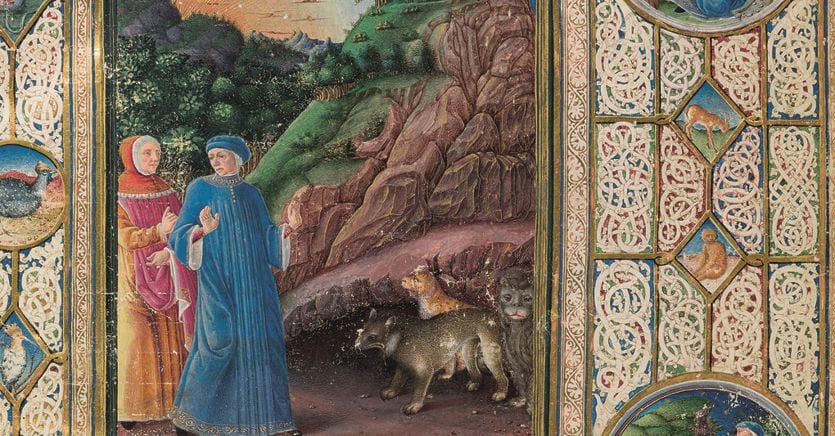The library, perhaps even more than the Doge’s Palace in which it was kept, celebrating its owner and exalting his qualities as a patron, suited to the person of a refined, cultured prince, lover of the arts, actually contributed to the construction of Frederick’s public image, as evidenced not only in the Quick by Vespasiano da Bisticci, who certainly was a biased witness, but also by other contemporaries who when they write about Federico do not fail to mention his book.
One of the collection’s masterpieces is the Dante Urbinate, today Urb. years. 365, unanimously considered the most beautiful manuscript of the Divine Comedy, a code with a very intriguing history, starting from the decision to make it. Two copies of the work were in fact already present in the library, in fourteenth-century codices, theUrb. years. 366, which today we know to be among the best examples of the text, at the top of the pedigreed books on which the critical edition of the work is built, and theUrb. years. 378. Both very similar to each other, probably of Florentine origin, they were very well made according to the traditional criteria of Gothic books, but they did not respond to the taste for the luxury book that Federico was tenaciously pursuing and which had also made him decide not to deal with books at print, which he considered cheesy.
Matteo de ‘Contugi, Guglielmo Giraldi
“Worthy” of his library, an appropriate expression of his magnificence, was to be the new one Comedy that he wanted to realize. The drafting was entrusted to Matteo de ‘Contugi, one of the most appreciated and famous Volterra copyists, who wrote in the very elegant humanistic handwriting then called old letter, and he had worked for a long time, among other things, for the Gonzagas in Mantua and for the Este in Ferrara. The writing of the volume, which has almost 300 sheets, was completed in Urbino and was finished at the end of the summer of 1478, when the copyist brought all the material, still in loose sheets, to Ferrara, to have the illustration realized in a book artist with whom he had already collaborated in the past, Guglielmo Giraldi. It was in the workshop of these that the general setting of the illustrations was given that should have been inserted in the white spaces left in the pages and it was there that the illumination of theInferno. A little later the group of Ferrarese artists, led by Giraldi’s main aide, Franco dei Russi, moved to Urbino, probably to ensure a more rapid conclusion of the work, which however stopped unexpectedly and suddenly in 1482, at the time of Federico’s death. It was almost the end of Purgatory, but the work was not finished. An attempt to continue it was made a few years later, but it was reduced to a single miniature and little else.
Over a century had to pass, during which the files were left unbound, before Francesco Maria II della Rovere, the last Duke of Urbino, attempted to recover the splendor of the court, starting a new period of artistic activity. Among the initiatives promoted, the conclusion of the miniatures of Dante Urbinate, for which preparatory drawings were also made. The completion of the Purgatory and the Paradiso were entrusted to Valerio Mariani, from Pesaro, who worked there with various aids between 1603 and 1616. In that year the codex is finally linked, with a yellow brocade blanket, and finds its place for the first time in the inventory of library.
Almost a century and a half had passed between the beginning and the end of the work to create the codex, which obviously reflects the two different decorative styles, fifteenth and seventeenth century. But the hardships of the beautiful book were not yet over. In 1631 the Duchy was annexed to the State of the Church, the death without heirs of Francesco Maria II della Rovere, and the manuscripts of the library, destined for his testamentary disposition to the community of Urbino, did not take the road to Rome as did others. city documents. In the following decades, there were several attempts to transfer the library, but only in June 1657, after exhausting negotiations, the community of Urbino decided to sell the manuscripts to Pope Alexander VII at a price, much lower than the actual value, of 10,000 scudi, which the pontiff added other benefits to allow the city to pay off the debts from which it was oppressed.
